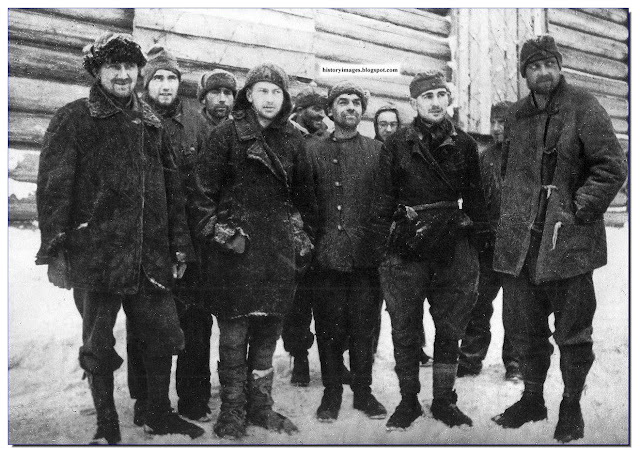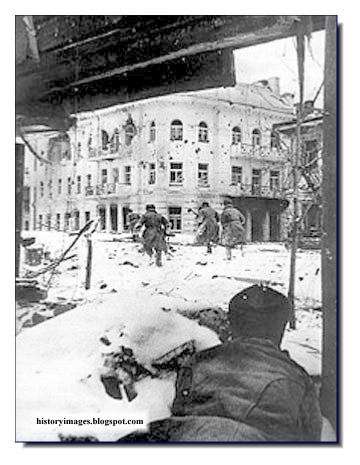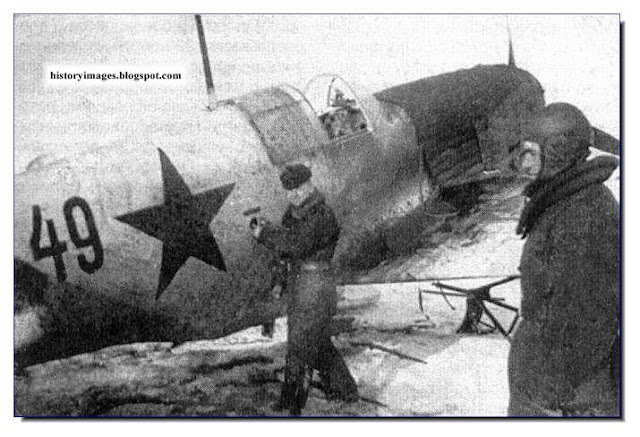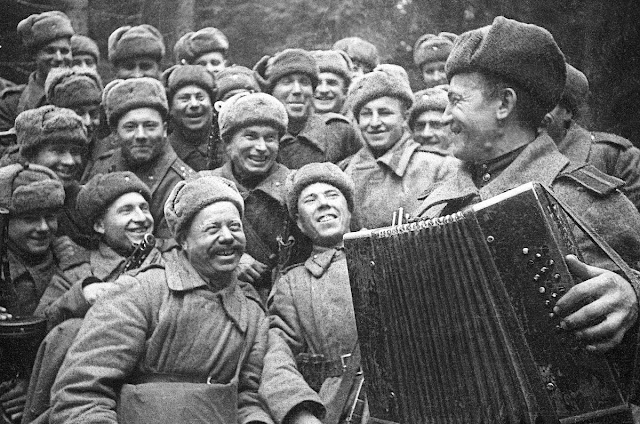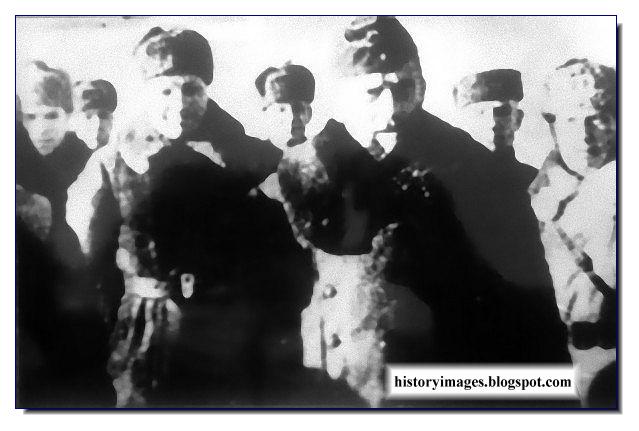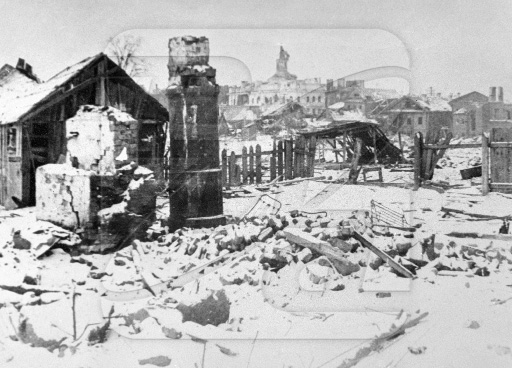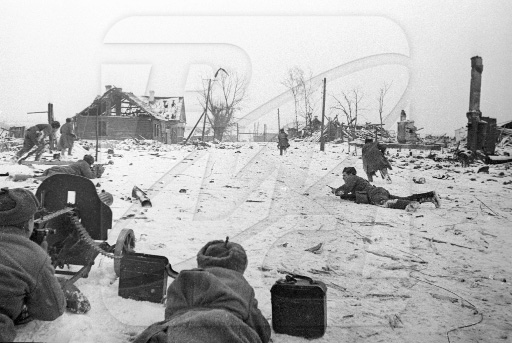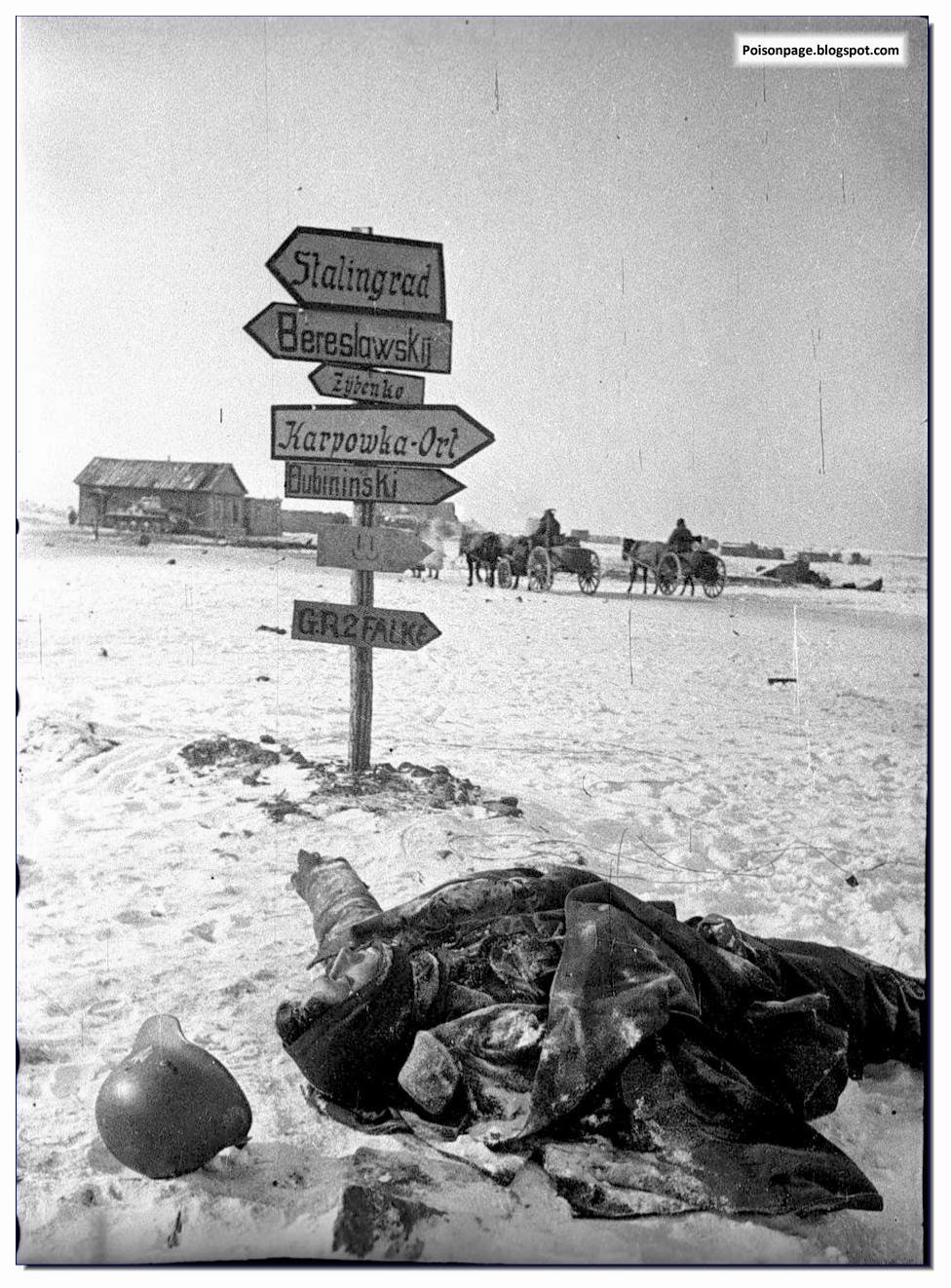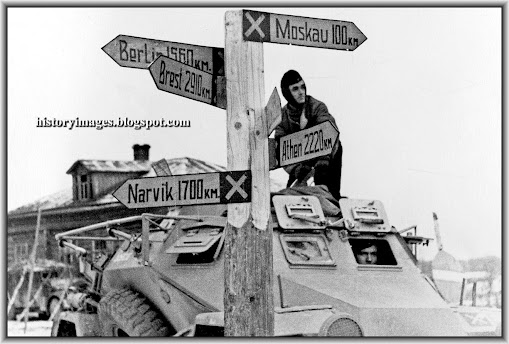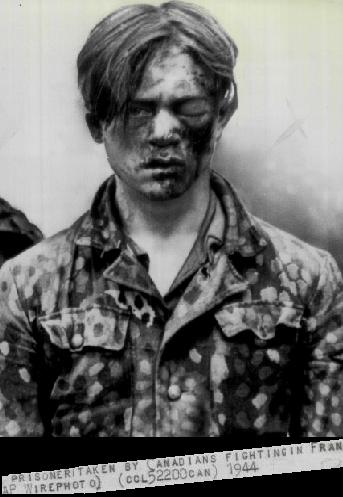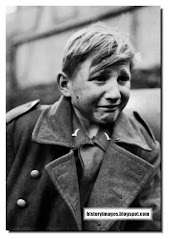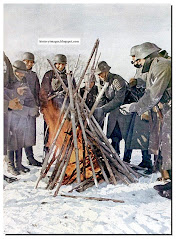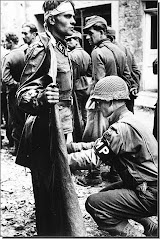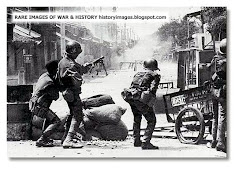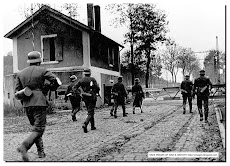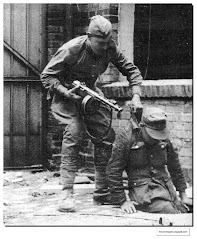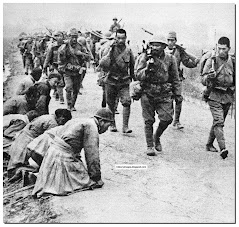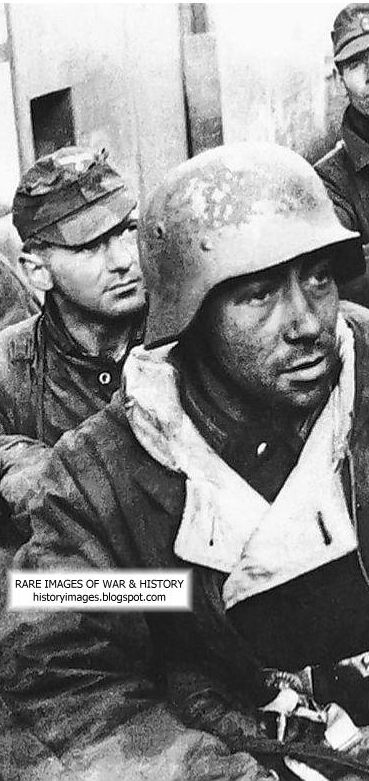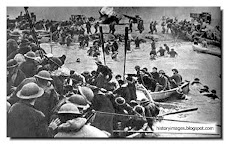Velikie Luki, a small town near Kalinin in North Russia saw some very fierce fighting at the same time when the ferocious Battle of Stalingrad raged in the south. Velikiye Luki ("Great Bow or Bend" in Russian) was important for the Russians because it lay on the railway line that linked the German Army North and Army Centre.
The small garrison of Germans in the town was surrounded by the Russians and the ensuing fighting was as fierce as that at Stalingrad. The town fell to the Russians in January 1943.
German soldiers taken prisoner in the Great Bow. December 1942. During Luki offensive November 24, 1942 - January 21, 1943 in the Great Bow was surrounded by a group of German troops after heavy fighting, and January 17, 1943. The 7000 strong German garrison was destroyed, and the city liberated by Soviet troops.
The battle for Velikiye Luki was a part of Soviet Operation "Mars" in November-December of 1942.
The actions against Velikiye Luki began in November, 25th by the troops of the right flank of the Kalinin Front.
In November, 28th the troops of the 3rd Shock Army ouflanked Velikiye Luki from both sides and encircled there the most part of the German 83rd Infantry Division (about 7,000 men).
The Germans sent two panzer, and one motorized divisions and one motorized brigade (it was in the time when Manstein tried to save the German troops in Stalingrad and to stop the Soviet advance) to breakthrough the encirclement around Velikiye Luki but their attempts had failed. The German panzers approached to Velikiye Luki on the distance of 10 kms but then they were repelled.
In January, 13th of 1943 the remains of Velikiye Luki's garrison had surrendered. The Soviets captured 4,000 soldiers and officers of the German 83rd Infantry Division there.
armchair general
In the wet snows of late November 1942, the Soviet army struck at the thinly manned German front lines north and south of the city on the river, surrounding the vital supply center and trapping its garrison while threatening to cut off and encircle an entire German army group. Adolf Hitler forbade a breakout and ordered that the surrounded troops be supplied by air. Relief attacks never quite had the necessary strength to break through the encircling Russians, and by late January 1943 the city was again in Russian hands, the German defenders either dead or taken prisoner. The encirclement of Velikiye Luki bore a strong resemblance to the well-known Nazi debacle that was unfolding at the same time at Stalingrad.
Historynet
The Soviet offensive began on November 24, with strong forces moving on Velikiye Luki from north and south, bypassing the screen of fortified positions in a semicircular arc east of the city. Encountering only scattered resistance and racing through the snow, by nightfall the Soviets had Velikiye Luki nearly surrounded. The German units dug in along the Kuban Stream were overrun so quickly that the Soviets were able to launch attacks against the city proper the next day. The attackers, however, were repulsed with heavy losses. More assaults came on the 26th, but again the Germans held. Russian attacks came almost daily in the following seven weeks. Although the Germans inflicted ruinous losses on the enemy, their own casualties mounted. On the 27th, the Soviet 357th Rifle Division completed the encirclement of the city. The last telephone call into Sass' headquarters came that day. From then on, communication with the trapped defenders was by radio only.
armchair general
(Click to enlarge map)
In the wet snows of late November 1942, the Soviet army struck at the thinly manned German front lines north and south of the city on the river, surrounding the vital supply center and trapping its garrison while threatening to cut off and encircle an entire German army group. Adolf Hitler forbade a breakout and ordered that the surrounded troops be supplied by air. Relief attacks never quite had the necessary strength to break through the encircling Russians, and by late January 1943 the city was again in Russian hands, the German defenders either dead or taken prisoner. The encirclement of Velikiye Luki bore a strong resemblance to the well-known Nazi debacle that was unfolding at the same time at Stalingrad.
Historynet
A Russian soldier beside a destroyed German panzer. Velikiye Luki. Early 1943
The Soviet offensive began on November 24, with strong forces moving on Velikiye Luki from north and south, bypassing the screen of fortified positions in a semicircular arc east of the city. Encountering only scattered resistance and racing through the snow, by nightfall the Soviets had Velikiye Luki nearly surrounded. The German units dug in along the Kuban Stream were overrun so quickly that the Soviets were able to launch attacks against the city proper the next day. The attackers, however, were repulsed with heavy losses. More assaults came on the 26th, but again the Germans held. Russian attacks came almost daily in the following seven weeks. Although the Germans inflicted ruinous losses on the enemy, their own casualties mounted. On the 27th, the Soviet 357th Rifle Division completed the encirclement of the city. The last telephone call into Sass' headquarters came that day. From then on, communication with the trapped defenders was by radio only.
------------------------
As the battle of Stalingrad raged in Southern Russia, an equally ferocious battle raged at Velikiye Luki in Northern Russia. It is called "little Stalingrad" by many historians.
-------------------
Heavy street fighting in Velikiye Luki
Velikiye Luki was crucial to both sides. To the Germans it was a bulwark protecting the vital railway supplying Army Group North, which passed through Novosokolniki some 20 kilometers to the west. Loss of that rail line might have forced Army Group North to lift the siege of Leningrad. Given Hitler's penchant for standing fast no matter what the military situation, this turn of events could have caused Army Group North to be trapped against the Gulf of Riga.
But if the German high command thought Velikiye Luki was important, the Soviet high command considered it crucial. Their efforts to recapture the city started in August 1941, soon after its capture, and continued almost without pause until January 1943. To the Soviets, the city's recapture meant much more than threatening the supply lines of Army Group North. The Russians' ultimate objective was to slice into the rear of Army Group Center, anchored 30 kilometers south at Velizh. Such a move would threaten to encircle and unhinge the entire German front. Smolensk would surely fall, and trapping Army Group North would merely be a bonus. The stakes were no less than the fate of two German army groups.
Soviet planes that took part in the battle
On January 15 1943, the last radio messages came from the eastern sector. At 0440 hours Sass (The German officer in charge of Velikiye Luki) radioed, 'A breakout appears out of the question; because almost 2,000 wounded would fall into Russian hands…help must immediately come from the outside. Urgently request reply.' Again at 0720 he sent: 'We cannot break out. You must immediately break through to us.' At 0840 came the last intelligible message from the beleaguered garrison: 'Urgently request artillery fire.' After that there was nothing. Velikiye Luki was officially declared lost on January 16.
Von Sass and seven other officers are stated to have been executed in the main square of Velikiye Luki in January 1946, after a tribunal convicted them of war crimes against POWs and civilians in and around the city.
A Propaganda picture? Russian soldiers enjoy music before going to battle in Velikiye Luki
Forlorn German POW after the siege of Velikiye Luki was over with grinning Russian soldiers. Most of the Germans were shot or hanged soon after
THE RUSSIANS DEALT WITH THE GERMAN POW RUTHLESSLY AFTER THE BATTLE
VIDEO: FIGHTING IN VELIYE LUKI
A Propaganda picture? Russian soldiers enjoy music before going to battle in Velikiye Luki
ESTIMATES OF LOSSES DURING THE VELIKIYE LUKI BATTLE
Russian. - 30,000 dead and thousands wounded.
More than 600 armored vehicles destroyed
400 guns lost.
63 aircraft destroyed.
German. - 17,000 dead and thousands of prisoners.
Hundreds of armored vehicles, antitank guns and artillery.
Over 80 bombers, transport aircraft, Heinkel He-111 and
Junkers Ju-53 destroyed.
Forlorn German POW after the siege of Velikiye Luki was over with grinning Russian soldiers. Most of the Germans were shot or hanged soon after
THE RUSSIANS DEALT WITH THE GERMAN POW RUTHLESSLY AFTER THE BATTLE
Revenge by the Soviets after the collapse of the citadel was rough. Each of the officers who fought in Velikie Luki were hanged in the plaza of the citadel. The others were sentenced to 20 to 25 years in prison. Only 11 returned to Germany between 1953 and 1955. The citadel of Velikie Luki was one of the most disputed point in the battle of winter 42-43.
MORE ON THE BATTLE OF VELIKIYE LUKI
Velikie Luki has been claimed as the birthplace of Marshal Konstantin Rokossovsky.
The city, which had 30,000 people at the beginning of the war was taken in August 1941 after heavy fighting, by the Lower Saxony Armored Division, units of the 20th Division of Hesse, and the 253rd Infantry Division.
First attempt to liberate the fortress. -
On January 1942, Captain General Yeremenko, and General Purkaiev, launched the offensive to relieve the critical situation on the Moscow front, the attack was a failure against the formidable rampart formed in the line Velikie Luki. The units of the 83 Infantry Division (transferred from France, in a hurry) defended the "Swamp City", an important route of entry in the path of Leningrad, Kiev, Moscow, to White Russia.
A Russian soldier covers the advance of his comrades. January 17, 1943. Velikiye Luki
Months later, the summer of 42, the 3rd Army Soviet assault attacked hard again with all kinds of artillery, but the 277th Grenadier Regiment, commanded by Colonel Von Rappard had fortified itself strongly in the city.
On November 19, 1942 began the second Russian offensive at Stalingrad, but first they had to seize Velikie Luki.
The offensive in Velikiye started in November 24. The attacks continued daily for seven weeks. The siege of the city was completed on November 27. The casualties on both sides were heavy, but for the German side were irreplaceable.
The city with over 20,000 defenders, of which 7.500 under the command of Lieutenant Colonel Sass guarded the front, consisted of grenadiers, gunners, sappers, health, railway troops, observers, and security forces.
Because the defensive perimeter was less than 18 square kilometers, Stukas were first used for giving supplies, however soon the food and ammunition were reduced by half.
The December 26th attack launched from the south and southeast with powerful armored formations, was fought house to house. The Russian rifle battalions fought with extraordinary courage, formed of the Komsomol (young communists).
On January 43, two strong pockets of resistance remained, the citadel and the railway station. The Germans defended the citadel with 427 men, and at the station, known by the name "Budapest position" stood Lieutenant Colonel von Sass with a thousand soldiers.
Food was depleting. The 300 horses had been eaten, bread was distributed among 10 men, and a can of meat amongst 20 men. The German soldiers were cold, tired, full of parasites, starving and being punished daily with 3000 shells of every caliber. Water (For which they had to risk their lives) was collected from a small pond.
There were several attempts to help the besieged by Colonel Baron Von Wolff. The Mitzlaff battalion made an assault on the hills to the east (and could see the towers of the citadel) but had to retire. The attempt by the famous 80 Reg Of Artillery Colonel Von Skotti was also a failure. After several attempts using paratroopers and armor, the Germans withdrew.
Only a small force of men managed to flee to German positions. The wounded Germans were left abandoned.
The commander of the German garrison at Velikiye Luki was Lieutenant Colonel von Sass.
Velikie Luki was declared lost by the Germans on January 16, 1943, although some fighting continued in the city, it was already in Russian hands.
---------------------------
THE STORY OF VELIKIYE LUKI
By mid-November 1942 the northernmost corps sector of Army Group Center extended seventy miles, from the town of Velizh north to the army group boundary. Inadequately covered by LIX Corps, the line contained two large gaps, each about ten miles wide and partly swampy but not entirely impassable. There, only reconnaissance and combat patrols provided a minimum of security. Despite persistent requests by the army group commander, no reinforcements arrived to strengthen the precarious German defenses on that sector.
Late in November the Russians attacked north and south of Velikiye Luki and succeeded in encircling the city which was held by a strong regimental combat team of the 83d Division. A few miles farther south two additional German combat teams suffered the same fate. Thus three separate German pockets completely cut of from the main force were created in the same general area.
Remains of the German garrison at Velikie Luki
By that time all available reserves of Army Group Center had been thrown into the fierce battle at Rzhev and could not be extricated for the relief of the encircled units in the Velikiye Luki area. The army group commander therefore requested authority from Army High Command to order breakouts of the encircled forces toward the west. If carried out at once, these could have been accomplished without great difficulty or excessive casualties, but it would have meant pulling the German line back about ten to fifteen miles. The new defense positions, as proposed by army group, would still assure the undisturbed operation of the Nevel-Novosokolniki-Nasva railroad, and the resulting Russian salient was then to be reduced, as soon as possible, by a German flank attack from the south.
(Click To Enlarge Map) Image source
Hitler, who in December 1941 had assumed direct control of all military operations in Russia, flatly rejected this proposal. Instead, he ordered that the pockets be held at all costs, that other German forces, by attacking from the west, re-establish contact with the encircled units, and that the front be pushed even farther to the east. He referred to a recent German success in a similar situation at Kholm by the same officer who now commanded the 83d Division in the area of Velikiye Luki. Army group tried in vain to call Hitler's attention to the lack of reserves and the extreme hardships imposed by winter weather and difficult terrain. All such representations were impatiently brushed aside.
The two German combat teams surrounded in the area south of Velikiye Luki meanwhile conducted a fighting withdrawal toward the west. With the assistance of other German forces, they broke out of encirclement and succeeded in establishing a new front.
At Velikiye Luki the Germans had previously constructed a perimeter of hasty field fortifications around the town. Advance positions, located several hundred yards from the edge of the city, proved of considerable value during the initial stages of the siege. The encircled garrison consisted of a strong infantry regiment of the 83d Division, two artillery battalions, one observation battalion, one engineer company, two construction battalions, and strong service and supply units. The pocket commander, a lieutenant colonel, had assumed command of his regiment only a few days earlier, and accordingly did not know his troops.
Main city building at Velikiye Luki after the guns fell silent
The enemy had so disposed his forces that at the beginning of December only two Russian brigades were deployed in a wide arc west of Velikiye Luki. As late as two weeks after the pocket was closed, a breakout in that direction would still have been possible, but despite the personal intervention of the army group commander, Hitler did not change his mind. The pocket was to be held, and should only be relieved by a push from the west.
With no reinforcements in sight, the troops required for this relief thrust could only be taken from other sectors of Army Group Center, all of which had been severely drained in an attempt at strengthening Ninth Army at Rzhev. The direction for the attack was to be from southwest to northeast with the so-called citadel a part of Velikiye Luki west of the Lovat River designated as the primary objective.
It was obvious that LIX Corps, already responsible for an excessively wide sector of the front, could not be expected to take on the additional task of conducting this attack. The situation not only called for the use of fresh combat units but also for the establishment of a new tactical headquarters to direct the proposed relief operation. Unable to pull out a corps headquarters from any other sector, army group had to resort to an improvisation. A provisional corps headquarters, Corps Woehler, was formed under the command of the army group chief of staff assisted by the army group training officer, the chief artillery officer, and another young staff officer. Subordinate to LIX Corps which remained responsible for supply and administration, the newly formed command group was ready to take charge of the front sector opposite Velikiye Luki by mid-December. Its command post, established on 15 December at Lovno, was no less improvised than the staff by which it was occupied. A one-room peasant hut had to serve as living and working quarters for six officers, three clerks, three drivers, and two orderlies.
The terrain designated for the attack was desolate, rolling country, virtually without forests. Here Stalin's scorched earth policy had been fully effective in the Russian retreat of 1941. Subsequent partisan operations completed the work of destruction. Most of the formerly inhabited places had vanished and even their last traces were now blanketed by heavy layers of snow. No roads or recognizable terrain features broke the monotony. Orientation was extremely difficult and at night a matter of pure chance. The entire area gave the impression of a landscape on the moon.
The German units initially available for the attack were a division from East Prussia, the 83d Division minus elements inside Velikiye Luki, the mountain regiment that had escaped encirclement south of the city, and two construction battalions. They had been weakened by considerable losses in men and materiel and were suffering from the effects of heavy frosts alternating with sudden thaws. Although their morale appeared unbroken, their combat value was definitely limited. Fortunately, their new commander, because of his experience as army group chief of staff, had no difficulty in finding out at what depots in the army group area ammunition and equipment could still be obtained. With railroads and transport planes doing their part, it took only a few days for the troops to be resupplied and re-equipped with new winter clothing. This brought about a rapid decline in the number of cold weather casualties.
Reinforced by a motorized division, a battalion of light infantry, two batteries of 105-mm. guns, and a rocket projector brigade, the improvised corps continued its preparations for the attack. They had to be cut short, however, since Hitler advanced the attack date by several days despite all objections by army group. The attack was launched shortly before Christmas but, after making good progress at first, bogged down at the half-way mark.
January 17, 1943. Russian troops on the outskirts of the city
By now it had become clear that additional forces of considerable strength would have to be brought up in order to achieve success. The reinforcements finally made available consisted of two divisions and one tank battalion. At least one of these divisions, however, proved wholly inadequate for the type of operation in which it was to participate. Originally used as an occupation unit in western Europe, it had recently been transferred east and employed as a security force on a quiet sector of the Russian front. Two of its regimental commanders were considerably over-age and incapable of leading their units in combat. The third regimental commander, who was still in good physical condition, actually had to command each of the three regiments in turn as they were successively committed in the attack.
Army group had requested the approval of the Air Force for the employment of a parachute division which was then in a quiet position southeast of Velizh.[Ed.: In the German system of organization, parachute units were part of the Luftwaffe.] Goering refused, insisting that the division remain intact in its present position. Undoubtedly this refusal was one of the chief reasons why the liberation of Velikiye Luki failed.
The second German relief thrust was launched early in January 1943. Leading elements advanced to less than five miles from the northwestern outskirts of the beleaguered city. At that stage, however, enemy pressure against the long flanks of the penetration forced the Germans to assume the defensive.
Inside the pocket, the citadel on the left bank of the Lovat River had meanwhile become the refuge for some 500 wounded from all parts of the city. On 5 January the Russians attacked from the north and succeeded in cutting through the town and severing the citadel from the main part of Velikiye Luki. Thus two separate pockets came into existence, each one precariously defended after the loss of all positions beyond the edge of the town, and particularly threatened by enemy attempts at infiltrating from block to block.
Liberating the main German force encircled in the eastern part of Velikiye Luki had become even more difficult. In any event, the immediate objective was to cut through the ring of encirclement that surrounded the smaller pocket west of the river. A general advance of the corps front, however, as demanded by Hitler, was by now definitely out of the question.
After lengthy negotiations the Air Force finally released one battalion of its parachute division for commitment at Velikiye Luki. It was too little and too late, but a last attempt had to be made to open a rescue corridor to the citadel. In order to bolster the fighting strength of the encircled garrison, a reinforced company of light infantry riding on trucks and tank destroyers was to ram its way through the enemy into the surrounded citadel. On 10 January, in a daring daylight attack, this force took the Russians by surprise and succeeded in joining the German defenders inside the pocket.
During the night of 14-15 January, the parachute battalion was to advance in a surprise attack to the southwest side of the citadel. There, by 0100, the fresh troops recently arrived in the pocket were to attempt a breakout, taking with them all wounded who were still able to march. Although initially led by a regimental commander familiar with the area, the parachute battalion lost its way in the featureless terrain and failed to reach its objective. The citadel force broke out nevertheless, and in the early morning hours, reduced by casualties to about 150 men, appeared at the corps' advance command post on the Novosokolniki-Velikiye Luki railroad line.
By now, irreplaceable losses in the ranks of the German relief force made it impossible to repeat the rescue attempt. Also, no more radio signals were coming from the eastern part of Velikiye Luki a clear indication that in six weeks of relentless fighting, despite the most determined resistance, the German force in the eastern pocket had been wiped out to the last man. The pocket commander's final radio message, received on 14 January, was, "With last strength and ammunition still holding two bunkers in center of city. Enemy outside my command post."
The struggle for Velikiye Luki was over. While it had the erect of tying down a greatly superior and constantly growing enemy force for six weeks, it also resulted in the annihilation of the German garrison, exorbitant casualties among the relief forces, and a loss of terrain along the entire corps sector. (Map 3) The important Nevel-Novosokolniki-Nasva railroad line still remained in German hands, free from enemy interference. However, the plan proposed by army group would have assured the same result without necessitating the futile struggle for Velikiye Luki. At the end of this ill-fated operation German casualties amounted to 17,000 officers and men, 5,000 of whom perished in the beleaguered city, while 12,000 were lost in rescue attempts from outside. Even if the relief thrust had eventually succeeded, the cost was far too high.
The experiences gained at Velikiye Luki might be summarized as follows:
1. Wherever a pocket comes into existence, it is usually the result of the attacker's numerical superiority over the encircled force. The deliberate adoption of a pocket-type defense can only be justified when early relief is assured; otherwise it will lead to the loss of the entire pocket force, and thus to a further decrease in the over-all fighting strength of the forces in the field.
2. The enemy's effective military strength, his combat troops, is his principle means of waging war. It must be destroyed. To fight constantly for terrain features, industrial installations, or simply for propagandistic purposes is to violate the basic principles of warfare.
3. It was Hitler who originally pronounced: "I must hold all pockets to the last in order to tie up superior enemy forces as long as possible." This may be correct in exceptional cases, but can never be elevated to the level of a general principle.
4. If an encircled force must be liberated by a relief thrust from the outside, only the best troops should be used in that operation. The more rapidly such a mission is completed, the fewer will be the casualties, and the greater the success. The maintenance for any length of time of a long, narrow salient obviously pointing at the pocket will involve murderous casualties. In the end such tactics are almost certain to fail because of the pressure exerted by the enemy on both flanks of the salient.
5. Speed is an absolute requirement, but should not be gained at the cost of hasty and inadequate preparations. The selection and assembly of the relief forces involves careful deliberation and considerable effort. In the situation described, the supreme commander, on whose specific order the date for the attack had been moved up, was far away from the fighting front, and the effect of this intervention proved disastrous. There was nothing to justify such lack of confidence in the judgment of the local commander or in the recommendations of army group.
6. Constant communication with the encircled forces was maintained via radio which functioned smoothly and met all requirements. On several occasions the artillery fire of the relief force was actually directed by observers inside the pocket. Shuttle flights by liaison aircraft were possible only in the beginning, and then only at night.
7. Having the light infantry unit break out of the citadel at night proved to be a wise decision. Direction toward the forward elements of the rescue force was maintained with the aid of prismatic compasses. Advancing in several single files, the men succeeded in inching their way forward through the hollows and silently overpowering the Russian sentries.
8. Supply of the German pocket was at first effected from reserve stocks available at Velikiye Luki. Soon, however, airdrops became necessary, marking the first occurrence of a situation that was later so characteristic of all German pockets in Russia the plight of encircled forces, inadequately supplied with ammunition, rations, and equipment, who were expected to do their utmost in a hopeless situation. If Hitler himself had ever been an eyewitness to such developments, Goering's arrogant promises of adequate air supply for German pockets might have been discounted once and for all. The Luftwaffe units concerned were not in any way to blame. The missions assigned to them proved impossible of fulfillment, but they did their duty again and again in a superior manner, at Velikiye Luki, as well as at Stalingrad, and in all subsequent cases where German ground troops found themselves in hopeless encirclement.
